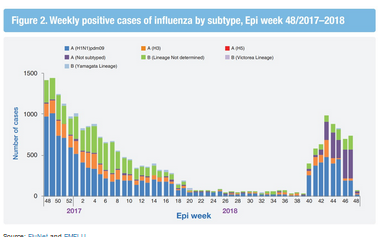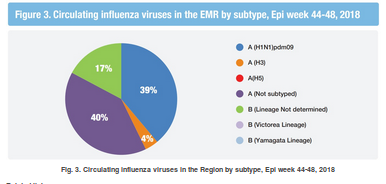#13,726
While we tend to think of the Northern and Southern Hemisphere flu seasons as singular, monolithic events - in truth, we often see large regional differences in the timing and dominant flu strains each flu season.
Last year, during the United State's record setting H3N2-centric flu season, Asia was battling primarily influenza B, while much of Europe and the Middle East were hit by a combination of H1N1 and Influenza B.Last January, in Eurosurveillance: Changes In Timing Of Influenza Epidemics - WHO European Region 1996-2016, we explored a study that found Western European countries have seen a discernible shift towards later flu season peaks, while the opposite was true in Eastern Europe and Russia.
Although H1N1 appears poised to be the dominant strain across the Northern Hemisphere winter, we monitor all regions for any signs of outliers or unusual activity.WHO EMRO has published the following summary of influenza activity reported during the month of November in the Eastern Mediterranean region, which builds on last months report, and shows a continued uptick in (primarily) Influenza A/H1N1 activity.
Epidemic and pandemic-prone diseases
Influenza monthly update, November 2018
In the WHO Eastern Mediterranean Region, influenza activity continues to increase in the month of November in many countries reporting data to FluNet and EMFLU namely, Afghanistan, Bahrain, Egypt, Iran (Islamic Republic of), Iraq, Jordan, Lebanon, Morocco, occupied Palestinian territory, Oman, Qatar, Saudi Arabia, Sudan, Syrian Arab Republic and Tunisia.
Influenza activity by subtype
• In November 2018, no new cases of human influenza A(H5N1) were reported in Egypt.
• In the northern Africa influenza transmission zone, A(H3) virus was detected predominantly in Egypt, while Morocco reported no activity.
• In the western Asia influenza transmission zone, Oman, Qatar and Saudi Arabia reported co-circulation of all seasonal influenza viruses, while in Bahrain influenza A(H1N1)pdm09 and A(H3) virus were detected. Jordan, occupied Palestinian territory and Syrian Arab Republic reported circulation of sporadic cases of the influenza A(H1N1)pdm09, while Iraq and Lebanon reported no activity.
• In southern Asia transmission zone, Iran (Islamic Republic of) reported circulation of all seasonal influenza viruses, while Afghanistan reported no activity.
Circulating influenza viruses by subtype
• During November 2018, national influenza centres and influenza laboratories in the Region tested a total of 10728 specimens for influenza viruses of which 3194 tested positive (30%).
• The average percentage of positivity rates is 30%, with highest positivity rate recorded in Bahrain and Qatar.
• Of the viruses tested; 2659 (83%) were influenza A viruses, including 1235 (39%) influenza A(H1N1)pdm09 virus and 142 (4%) were influenza A(H3) virus. Influenza B (Lineage Not determined) virus accounted for 533 (17%) (Figure 3).
While we're seeing increased flu activity in South Korea, Canada, and the Middle East - influenza activity remains relatively low in Europe, Hong Kong, the United States, and Russia.
A happy circumstance that is unlikely to persist much longer.


